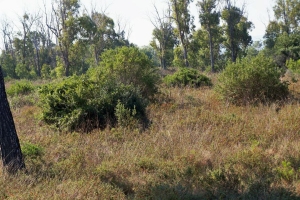Inhalt
1. Lebendfotos
1.1. Falter
1-2: ♂, Italien, Apulien, Gargano, Capoiale, Strandnähe, 5 m, 41.912059, 15.714298, 10. August 2020, am Licht (leg., gen. det. & fot.: Friedmar Graf)Forum
2. Diagnose
2.1. Männchen
1: ♂, Italien, Apulien, Gargano, Capoiale, Strandnähe, 5 m, 41.912059, 15.714298, 10. August 2020, am Licht (leg., gen. det. & fot.: Friedmar Graf)Forum
2.2. Geschlecht nicht bestimmt
1: Spanien, Kanarische Inseln, La Palma, Vico de Mazo, Tiguerote, Barranco de la Lava, 465 m, 8. August 2011 (leg., det. und Foto: Andreas Kopp)Forum
2.3. Genitalien
2.3.1. Männchen
1-3: ♂, Italien, Apulien, Gargano, Capoiale, Strandnähe, 5 m, 41.912059, 15.714298, 10. August 2020, am Licht (leg., gen. det. & fot.: Friedmar Graf), Referenz Genital: Huemer & Karsholt, ME 6 Gelechiidae I, ♂ Fig. 26Forum
2.4. Erstbeschreibung
1-2: Stainton (1869: 211-212) [nach Copyright-freien Scans auf www.biodiversitylibrary.org]
3. Biologie
3.1. Habitat
1-2: Lichtfangstandort, Italien, Apulien, Gargano, Capoiale, Strandnähe, 5 m, 41.912059, 15.714298, 10. August 2020 (fot.: Friedmar Graf)Forum
3.2. Nahrung der Raupe
- [Cistaceae:] Cistus salviifolius [= Cistus salviaefolius] (Salbeiblättrige Zistrose)
- [Cistaceae:] Cistus albidus (Weißliche Zistrose)
- [Cistaceae:] Cistus monspeliensis (Montpellier-Zistrose)
- [Cistaceae:] Halimium lasianthum subsp. alyssoides [= Halimium occidentale]
Die Raupe lebt an Zistrosen i.w.S. (Cistus und Halimium). Schon Stainton (1869: 211-212) berichtet: "I reared two specimens of this species, from larvae collected by Monsieur Millière an Cistus salvifolius at Cannes in March 1866 [...] Last summer Monsieur Millière sent me a specimen bred from Cistus albidus". Walsingham (1908: 936) ergänzt Cistus monspeliensis nach einem eigenem Raupenfund bei Guimar auf Teneriffa. Zerkowitz (1946: 133) nennt für Portugal: "Foodplant: Halimium occidentale", also eine Pflanze, die auch schon in der Gattung Cistus geführt wurde; auch hier ist es nach dem Zusammenhang sehr wahrscheinlich, dass der Meldung ein Raupenfund zugrunde liegt.
(Autor: Erwin Rennwald)
4. Weitere Informationen
4.1. Andere Kombinationen
- Gelechia cisti Stainton, 1869 [Originalkombination]
- Teleiodes cisti (Stainton, 1869)
4.2. Literatur
- Gastón, J. & A. Vives Moreno (2023): Nuevos registros de Heterocera para España, con la descripción de una nueva especie (Insecta: Lepidoptera). — SHILAP Revista de lepidopterología 51 (201): 101-121. [DF auf shilap.org]
- Erstbeschreibung: Stainton, H. T. (1869): The Tineina of Southern Europe. i-viii + 1-372 + 1 pl. London (John van Voorst).
- Walsingham (1908): Microlepidoptera of Tenerife. — The Proceedings of the Zoological Society of London for the Year 1907: 911-1034 + pl. LI-LIII.
- Zerkowitz, A. (1946): The Lepidoptera of Portugal. — Journal of the New York Entomological Society, : 51-87, 115-165, 211-261. [Digitalisat auf Biodiversitylibrary.org]




![Vorkommen in Frankreich (europäisches Territorium ohne Korsika) [Vandromme et al. (2020): Liste systématique et taxinomique des Lépidoptères de France]](/res/img/flag/fr.gif)
![Vorkommen auf Korsika [Brusseaux, G. & J. Nel (2004)]](/res/img/flag/fr-cor.png)
![Einzelnachweis in Spanien (Festland) [Gastón & Vives Moreno (2023: 104)]](/res/img/flag/es.gif)
![Vorkommen auf den Kanarischen Inseln [Vives Moreno, A. (2014)]](/res/img/flag/es-cn.png)
![Vorkommen in Portugal (Festland) [Corley (2015): Lepidoptera of Continental Portugal]](/res/img/flag/pt.gif)
![Vorkommen in Italien (Festland und kleine festlandsnahe Inseln) [Baldizzone et al. (1995): Checklist delle Specie della Fauna Italiana 83]](/res/img/flag/it.gif)
![Vorkommen auf Sardinien [Baldizzone et al. (1995): Checklist delle Specie della Fauna Italiana 83]](/res/img/flag/it-sar.png)
![Einzelnachweis in Kroatien [Karsholt, Baldizzone & Gomboc (2023)]](/res/img/flag/hr.gif)
![Vorkommen in Griechenland (Festland und festlandsnahe Inseln) [Gozmany (2012): The Lepidoptera of Greece and Cyprus Volume I]](/res/img/flag/gr.png)
![Vorkommen auf Kreta [Gozmany (2012): The Lepidoptera of Greece and Cyprus Volume I]](/res/img/flag/gr.gif)
![Vorkommen auf Zypern [Gozmany (2012): The Lepidoptera of Greece and Cyprus Volume I]](/res/img/flag/cy.gif)
![Vorkommen im europäischen und/oder asiatischen Teil der Türkei [Koçak & Kemal (2018) ohne Angabe einer Provinz]](/res/img/flag/tr.gif)











